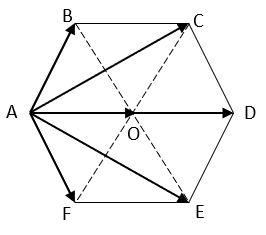
ABCDEF is a regular hexagon. The centre of hexagon is at point O. Then the value of $\vec{AB}+\vec{AC}+\vec{AD}+\vec{AE}+\vec{AF}$ is
A. $2\vec{AO}$
B. $4\vec{AO}$
C. $6\vec{AO}$
D. Zero
Answer
585k+ views
Hint: Draw a regular hexagon and locate the vectors given. Then apply the parallelogram law of vector addition to change the given vectors in terms of the vector given in options. Then after changing them, add them all to get the final solution.
Complete step by step solution:
We have been given a regular hexagon ABCDEF with O at its center. And we have to find the value of $\vec{AB}+\vec{AC}+\vec{AD}+\vec{AE}+\vec{AF}$.
Let us draw the hexagon and indicate the given vector,

Now, using parallelogram law of vector addition we can write $\vec{AC}=\vec{AB}+\vec{AO}$ ………. (i)
Similarly, $\vec{AE}=\vec{AF}+\vec{AO}$ ………. (ii)
Also, we can notice from the diagram that $\vec{AD}=2\vec{AO}$ ………. (iii)
Using equations (i), (ii) and (iii) in the given problem, we can write
$\vec{AB}+\vec{AC}+\vec{AD}+\vec{AE}+\vec{AF}=\vec{AB}+\vec{AB}+\vec{AO}+2\vec{AO}+\vec{AF}+\vec{AO}+\vec{AF}$
$=2(\vec{AB}+\vec{AF})+4\vec{AO}$
Using parallelogram law of addition, we have $\vec{AB}+\vec{AF}=\vec{AO}$
Therefore, $2(\vec{AB}+\vec{AF})+4\vec{AO}=6\vec{AO}$
Hence, option c is the correct answer.
Additional information:
We generally use two types of vector addition techniques; one is the triangle law and other one is parallelogram law of vector addition.
Triangle law of vector addition states that when we represent two sides of a triangle as two vectors, then the third side will represent the resultant vector of other two vectors. here, the sides represent the direction, order and magnitude.
Parallelogram law of vector addition states that if two vectors are represented by two sides of a parallelogram, then their sum will represent the diagonal vector through their common point.
Note: Both the laws of vector addition should be conceptually clear and once should know when to use what law or else it may lead to confusion. And while applying the laws of vector addition, one should be extra careful in determining which diagonal is formed by adding up which sides.
Complete step by step solution:
We have been given a regular hexagon ABCDEF with O at its center. And we have to find the value of $\vec{AB}+\vec{AC}+\vec{AD}+\vec{AE}+\vec{AF}$.
Let us draw the hexagon and indicate the given vector,

Now, using parallelogram law of vector addition we can write $\vec{AC}=\vec{AB}+\vec{AO}$ ………. (i)
Similarly, $\vec{AE}=\vec{AF}+\vec{AO}$ ………. (ii)
Also, we can notice from the diagram that $\vec{AD}=2\vec{AO}$ ………. (iii)
Using equations (i), (ii) and (iii) in the given problem, we can write
$\vec{AB}+\vec{AC}+\vec{AD}+\vec{AE}+\vec{AF}=\vec{AB}+\vec{AB}+\vec{AO}+2\vec{AO}+\vec{AF}+\vec{AO}+\vec{AF}$
$=2(\vec{AB}+\vec{AF})+4\vec{AO}$
Using parallelogram law of addition, we have $\vec{AB}+\vec{AF}=\vec{AO}$
Therefore, $2(\vec{AB}+\vec{AF})+4\vec{AO}=6\vec{AO}$
Hence, option c is the correct answer.
Additional information:
We generally use two types of vector addition techniques; one is the triangle law and other one is parallelogram law of vector addition.
Triangle law of vector addition states that when we represent two sides of a triangle as two vectors, then the third side will represent the resultant vector of other two vectors. here, the sides represent the direction, order and magnitude.
Parallelogram law of vector addition states that if two vectors are represented by two sides of a parallelogram, then their sum will represent the diagonal vector through their common point.
Note: Both the laws of vector addition should be conceptually clear and once should know when to use what law or else it may lead to confusion. And while applying the laws of vector addition, one should be extra careful in determining which diagonal is formed by adding up which sides.
Recently Updated Pages
Why are manures considered better than fertilizers class 11 biology CBSE

Find the coordinates of the midpoint of the line segment class 11 maths CBSE

Distinguish between static friction limiting friction class 11 physics CBSE

The Chairman of the constituent Assembly was A Jawaharlal class 11 social science CBSE

The first National Commission on Labour NCL submitted class 11 social science CBSE

Number of all subshell of n + l 7 is A 4 B 5 C 6 D class 11 chemistry CBSE

Trending doubts
What is meant by exothermic and endothermic reactions class 11 chemistry CBSE

10 examples of friction in our daily life

One Metric ton is equal to kg A 10000 B 1000 C 100 class 11 physics CBSE

1 Quintal is equal to a 110 kg b 10 kg c 100kg d 1000 class 11 physics CBSE

Difference Between Prokaryotic Cells and Eukaryotic Cells

What are Quantum numbers Explain the quantum number class 11 chemistry CBSE




